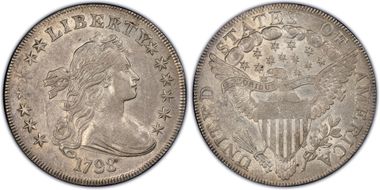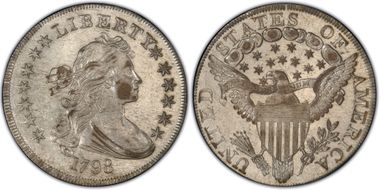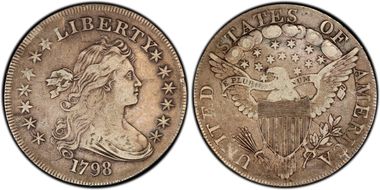1798 $1 BB-125 AU55 认证号27942489, PCGS号40042
专家评论
Q. David Bowers
The following narrative, with minor editing, is from my "Silver Dollars & Trade Dollars of the United States: A Complete Encyclopedia" (Wolfeboro, NH: Bowers and Merena Galleries, Inc., 1993). Note: the Notable Specimens list should be used with caution - it has been updated in my 2013 edition of "The Encyclopedia of United States Silver Dollars 1794-1804.""Misoriented Star Reverse."
Arc star pattern on reverse. (B-8. H-8.)
OBVERSE 19: Stars on right very close to Y and bust. Long vertical die flaw in center of left obverse field (best seen on strong VF or better pieces). Rounded off bottom to 7. Die "dot" near edge between two denticles above left part of T in LIBERTY. 9 shows slight doubling at top. A crack from lower right part of E to hair. On the left, more space between stars 5 and 6 than between any others. On the right, more space between stars 8 and 9 than between any others. The obverse stars at the left gradually weaken from die failure, and examples can be found appearing to have only 12, 11-1/2, 11, 10-1/2, 10, or 9 stars. (The Numismatist, May 1966, printed an article by R.N. Shepherd, "New Variety 1798 Silver Dollar?" in which the author opined that his specimen of B-S [BB-125], with just 12 stars (the 5th obverse star was missing) might be a new variety. Further: "If it is unique, it is more rare than the fabulous IS04 dollars. [The ownership of the coin is] the thrill of my life.") Such pieces are sometimes sold as damaged coins as they appear, to the untrained eye, to have been plugged.
Obverse die used to strike 1795 BB-125 only.
REVERSE U: Only four berries, and these are large. The only four-berry reverse of the year. Arc star pattern. Star ray at eagle's lower beak (only three arc-pattern reverse dies, those used to coin BB-116, BB-117, and BB-125 have the ray at beak); another ray of same star points to between B and U, closer to U. Right most star is misoriented and has two rays toward the top of the coin, instead of the normal vertical orientation of one ray pointing straight up and the other straight down, the only such skewing of a star on the reverse of a 1798 dollar. Nearby star under cloud 7 is considerably tilted. 12 arrows plus one detached head; two rightmost arrows are overlaid with other arrows, with heads part way down each shaft, as is another arrow near the middle; fifth arrow from right (on the third shaft from right, considering the doubling-up of the two right most arrows) is tiny and misformed. Light crack from border through upper left part of E in STATES. Point of leaf under left upright of I in AMERICA. The reverse is often weak, especially at the lower part of TED and at the right corner of the ribbon.
Reverse die used to strike 1795 BB-125 only.
DIE STATES:
Die State I: Perfect dies. May not exist.
Die State II: With die cracks as described by Bolender. Stars are weak on the obverse, and on the reverse Nand E of UNITED are very weak. Most BB-125 dollars are of this state.
Die State III: Bolender-8a: With die cracks as follows: Die crack on obverse through L to ribbon. Die crack lump on lower curl to left of date. Clash marks slightly above bust line and parallel to it. Reverse: The reverse die is now shattered with numerous cracks. A crack through top of UNIT down through ED, top of S, above TA, top of TES. Cracks through both top and bottom of OF, continue to AM, and top of ER. Another crack down through C and branch to shield. Another crack through arrow butts, eagle's tail, and stem to right. About 25% of surviving BB-125 dollars are of this state.
Die State IV: Later die state than III. On the obverse, star 5 cannot be seen, and star 7 is barely visible, due to die failure. One reverse crack starts at the lower right part of the M in AMERICA and runs to the ribbon, right shield top and the U in UNUM. A second crack begins at the top of the eagle's head and runs to the fourth cloud (counting from left to right.) UNITED is very weak, due to die buckling.
Die State V: State later than the following, with reverse die shattered and exhibiting over a dozen different cracks. Hall: 1675 had the most advanced cracks of any example seen. Spies' "Bolender-8e" was described as from a "badly shattered" reverse; "there must be 15 different die breaks."
COLLECTING NOTES: 1798 BB-125 shares honors with BB-105 as one of the two most common varieties of the year and, indeed, one of the most common early dollars of any date. Close to 1,000 are known, and the actual number may be over that. Most specimens are in lower states of preservation from VG to VF, although EF coins are scattered throughout auction history, as are a few AU pieces. No Mint State coins are known to the author. The F.C.C. Boyd ("World's Greatest Collection," 1945) and Bolender Collection (1952) specimens were each only VF. The W. Earl Spies Collection (Stack's, 1974) was notable for having five different die states of BB-125. This variety is surprisingly rare in higher grades; there must be some special story concerning how they were distributed.
NOTABLE SPECIMENS:
DeCoppet Specimen. AU-55. James Kelly, Andre DeCoppet Collection, 1955. Choice AU.
Cohen Specimen. AU-53. Bowers and Merena, Cohen Collection, 1955: 301. "Well struck. Light smoky gray toning overlays frosty mint brilliance. The surfaces are immaculate. An interesting vertical die break is in the left obverse field."
Auction '87 Specimen. AU-50. Superior, Auction '87. 1987:1813. "The surfaces are lustrous and lightly marked. Some unusual colorful toning of an unknown origin is visible on the obverse and reverse."
Hall Specimen. AU-50. Bowers and Ruddy, Hall Collection, 1975:1675. "AU-50 and still quite lustrous. Struck from shattered dies, resulting in a characteristic weakness in a few places and in some interesting die breaks."
Newport Specimen. AU-50. Bowers and Ruddy, Newport Collection, 1975:1041. "Lustrous AU with a pleasing golden tone. Full mint lustre, except for the very highest parts of the coin, is visible under the beautiful patina."
Ross Specimen. AU-50. Stack's, Ross Collection, 1990:401. "AU, bold strike, pale russet centers, a band of neon blue and sea green around the obverse periphery."
ANA Convention Sale Specimen. EF-45. Heritage, ANA Convention Sale, 1955:948. "Advanced die state with numerous reverse breaks and weakness through the centers. Steel gray surfaces which retain much underlying lustre. Splashes of brownish-violet and vivid aqua coloration on either side. Small obverse edge bump at 9:00."
Ebsen Specimen. EF-45. Superior, Buddy Ebsen Collection, 1987:1895. "EF-45. Well struck and perfectly centered on a problem-free planchet."
New Netherlands Spedmen. EF-45. New Netherlands Coin Company's 57th Sale, 1963, offered a specimen catalogued as better than EF (say, EF-45).
PCGS #
40042
设计师
Robert Scot
边缘
Lettered: HUNDRED CENTS ONE DOLLAR OR UNIT
直径
40.00 毫米
重量
27.00 克
铸币数量
287536
金属成分
90% Silver, 10% Copper
更高评级数量
0
评级较低的钱币数量
28
地区
The United States of America
价格指南
PCGS 数量报告
拍卖 - PCGS 评级的
拍卖 - NGC 评级的























